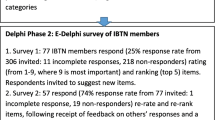Abstract
The National Heart, Lung, and Blood Institute and the National Institutes of Health Office of Disease Prevention convened a meeting on August 29-30, 2013 entitled “Obesity Intervention Taxonomy and Pooled Analysis.” The overarching goals of the meeting were to understand how to decompose interventions targeting behavior change, and in particular, those that focus on obesity and to combine data from groups of related intervention studies to supplement what can be learned from the individual studies. This paper summarizes the workshop recommendations and provides an overview of the two other papers that originated from the workshop and that address decomposition of behavioral change interventions and pooling of data across diverse studies within a consortium.
Similar content being viewed by others
References
Yeh HC, Clark JM, Emmons KE, et al. Independent but coordinated trials: insights from the practice-based Opportunities for Weight Reduction Trials Collaborative Research Group. Clin Trials. 2010; 7(4): 322-332.
Lytle LA, Svetkey LP, Patrick K, et al. The EARLY trials: a consortium of studies targeting weight control in young adults. Transl Behav Med. 2014; 4(3): 304-313.
Pratt CA, Boyington J, Esposito L, et al. Childhood Obesity Prevention and Treatment Research (COPTR): interventions addressing multiple influences in childhood and adolescent obesity. Contemp Clin Trials. 2013; 36(2): 406-413.
Czajkowski SM, Powell LH, Adler N, et al. From ideas to efficacy: the ORBIT model for developing behavioral treatments for chronic diseases. Health Psychol. 2 Feb 2015.
Dooyema CA, Belay B, Foltz JL, Williams N, Blanck HM. The childhood obesity research demonstration project: a comprehensive community approach to reduce childhood obesity. Child Obes. 2013; 9(5): 454-459.
Ory MG, Jordan PJ, Bazarre T. The behavior change consortium: setting the stage for a new century of health behavior-change research. Health Educ Res. 2002; 17(5): 500-511.
Ory MG, Lee Smith M, Mier N, Wernicke MM. The science of sustaining health behavior change: the Health Maintenance Consortium. Am J Health Behav. 2010; 34(6): 647-659.
Schulz R, Belle SH, Czaja SJ, et al. Introduction to the special section on Resources for Enhancing Alzheimer’s Caregiver Health (REACH). Psychol Aging. 2003; 18(3): 357-360.
Foltz JL, Belay B, Dooyema CA, Williams N, Blanck HM. Childhood Obesity Research Demonstration (CORD): the cross-site overview and opportunities for interventions addressing obesity community-wide. Child Obes. 2015; 11(1): 4-10.
O’Connor DP, Lee RE, Mehta P, et al. Childhood Obesity Research Demonstration project: cross-site evaluation methods. Child Obes. 2015; 11(1): 92-104.
Czaja SJ, Schulz R, Lee CC, Belle SH, Investigators R. A methodology for describing and decomposing complex psychosocial and behavioral interventions. Psychol Aging. 2003; 18(3): 385-395.
Belle SH, Czaja SJ, Schulz R, et al. Using a new taxonomy to combine the uncombinable: integrating results across diverse interventions. Psychol Aging. 2003; 18(3): 396-405.
Ayala GX, Ibarra L, Binggeli-Vallarta A, et al. Our Choice/Nuestra Opcion: the Imperial County, California, Childhood Obesity Research Demonstration study (CA-CORD). Child Obes. 2015; 11(1): 37-47.
Taveras EM, Blaine RE, Davison KK, et al. Design of the Massachusetts Childhood Obesity Research Demonstration (MA-CORD) study. Child Obes. 2015; 11(1): 11-22.
Hoelscher DM, Butte NF, Barlow S, et al. Incorporating primary and secondary prevention approaches to address childhood obesity prevention and treatment in a low-income, ethnically diverse population: study design and demographic data from the Texas Childhood Obesity Research Demonstration (TX CORD) study. Child Obes. 2015; 11(1): 71-91.
Belle SH, Burgio L, Burns R, et al. Enhancing the quality of life of dementia caregivers from different ethnic or racial groups: a randomized, controlled trial. Ann Intern Med. 2006; 145(10): 727-738.
Schulz R, Czaja SJ, McKay JR, Ory MG, Belle SH. Intervention taxonomy (ITAX): describing essential features of interventions. Am J Health Behav. 2010; 34(6): 811-821.
Michie S, Ashford S, Sniehotta FF, Dombrowski SU, Bishop A, French DP. A refined taxonomy of behaviour change techniques to help people change their physical activity and healthy eating behaviours: the CALO-RE taxonomy. Psychol Health. 2011; 26(11): 1479-1498.
Michie S, Richardson M, Johnston M, et al. The behavior change technique taxonomy (v1) of 93 hierarchically clustered techniques: building an international consensus for the reporting of behavior change interventions. Ann Behav Med. 2013; 46(1): 81-95.
Acknowledgments
The three manuscripts described in this journal were supported by the National Heart, Lung, and Blood Institute, the Eunice Kennedy Shriver National Institute of Child Health and Human Development, the NIH Office of Behavioral and Social Science Research, the NIH Office of Disease Prevention, National Institute of Digestive, Diabetes, and Kidney Diseases, National Center for Complementary and Integrative Health, National Cancer Institute, Office of Research on Women’s Health, and the Centers for Disease Control and Prevention (CDC). The findings and conclusions are those of the authors and do not necessarily represent the official position of the National Institutes of Health or the Centers for Disease Control and Prevention.
Author information
Authors and Affiliations
Corresponding author
Ethics declarations
Conflict of interest
Dr. Cella reports funding from the NHLBI. No other authors reported a potential conflict of interest.
Adherence to ethical principles
This research did not include human subjects or animals.
Additional information
Implications
Researchers: Use the behavioral change techniques (taxonomy approach) that decompose each intervention component and determine intervention dose when combining information from studies that employ similar interventions.
Practitioners: Use information from multiple studies rather than individual studies to provide better information regarding behavior change.
Policymakers: Take advantage of information that comes from several studies for data-driven policy decisions.
About this article
Cite this article
Belle, S.H., Stevens, J., Cella, D. et al. Overview of the obesity intervention taxonomy and pooled analysis working group. Behav. Med. Pract. Policy Res. 6, 244–259 (2016). https://doi.org/10.1007/s13142-015-0365-5
Published:
Issue Date:
DOI: https://doi.org/10.1007/s13142-015-0365-5




